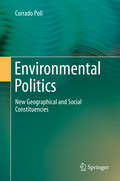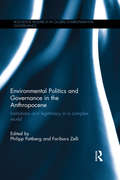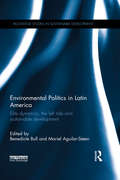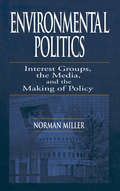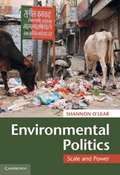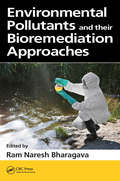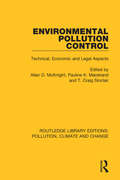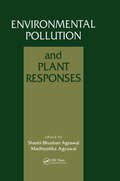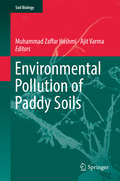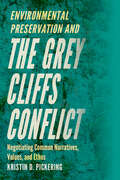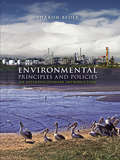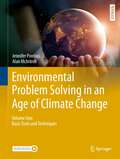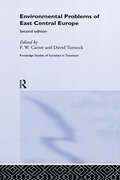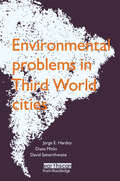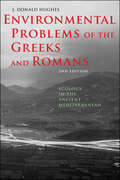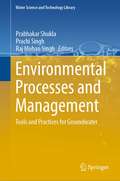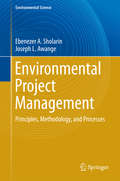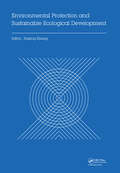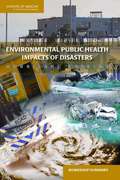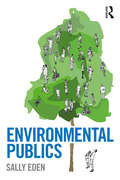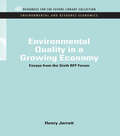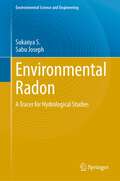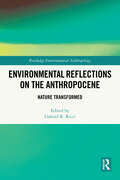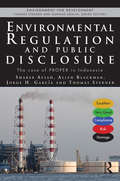- Table View
- List View
Environmental Politics
by Corrado PoliA change in the way humans relate to nature could be the starting point for a new politics, which will also affect relations among humans. A new approach would help to radically transform the production system, not because it is unjust in the usually considered social terms, but because it endangers nature and humanity. So far, the citizens' grassroots organizations have failed to win broad consensus and political power in the representative institutions. When the time comes to transform the single environmental issue into an electoral platform, environmentalists lose unity and effectiveness since they lack a common political vision and an ensuing strategy. On the other hand European politics is rapidly transforming because the challenge brought by so-called populist movements. We need to transform activists' shared emotions and attitudes into political ideologies and platforms. Moreover, a new educational process and a new science politics are necessary to reform environmental policy.
Environmental Politics and Governance in the Anthropocene: Institutions and legitimacy in a complex world (Routledge Research in Global Environmental Governance)
by Fariborz Zelli Philipp PattbergThe term Anthropocene denotes a new geological epoch characterized by the unprecedented impact of human activities on the Earth’s ecosystems. While the natural sciences have advanced their understanding of the drivers and processes of global change considerably over the last two decades, the social sciences lag behind in addressing the fundamental challenge of governance and politics in the Anthropocene. This book attempts to close this crucial research gap, in particular with regards to the following three overarching research themes: (i) the meaning, sense-making and contestations emerging around the concept of the Anthropocene related to the social sciences; (ii) the role and relevance of institutions, both formal and informal as well as international and transnational, for governing in the Anthropocene; and (iii) the role and relevance of accountability and other democratic principles for governing in the Anthropocene. Drawing together a range of key thinkers in the field, this volume provides one of the first authoritative assessments of global environmental politics and governance in the Anthropocene, reflecting on how the planetary scale crisis changes the ways in which humans respond to the challenge. This volume will be of great interest to students and scholars of global environmental politics and governance, and sustainable development.
Environmental Politics in Latin America: Elite dynamics, the left tide and sustainable development (Routledge Studies in Sustainable Development)
by Benedicte Bull Mariel Cristina Aguilar-StoenSince colonial times the position of the social, political and economic elites in Latin America has been intimately connected to their control over natural resources. Consequently, struggles to protect the environment from over-exploitation and contamination have been related to marginalized groups’ struggles against local, national and transnational elites. The recent rise of progressive, left-leaning governments – often supported by groups struggling for environmental justice – has challenged the established elites and raised expectations about new regimes for natural resource management. Based on case-studies in eight Latin American countries (Argentina, Brazil, Chile, Ecuador, Colombia, Bolivia, El Salvador and Guatemala), this book investigates the extent to which there have been elite shifts, how new governments have related to old elites, and how that has impacted on environmental governance and the management of natural resources. It examines the rise of new cadres of technocrats and the old economic and political elites’ struggle to remain influential. The book also discusses the challenges faced in trying to overcome structural inequalities to ensure a more sustainable and equitable governance of natural resources. This timely book will be of great interest to researchers and masters students in development studies, environmental management and governance, geography, political science and Latin American area studies.
Environmental Politics: Interest Groups, the Media, and the Making of Policy
by Norman MillerAt every stage, environmental policy is the result of the combat of stakeholders interested in, and affected by, the problem being addressed and the range of possible solutions. The combatants include any or all of the following: the federal government, environmental advocacy groups, and business, the media, the scientific community, think tanks, NGOs of every stripe, trade associations and professional organizations, and even state and local governments, each of whom have their own interests in the resulting policy. Environmental Politics: Interest Groups, the Media, and the Making of Policy discusses political battles over the environment from ground level - as they are fought in legislative chambers, the daily newspaper, on television, and, increasingly, on the Internet. The text explores environmental politics as a clash of interests, not ideologies, and environmental policy as a result of the reconciliation of those interests.
Environmental Politics: Scale and Power
by Shannon O'LearShannon O'Lear brings a geographer's perspective to environmental politics. The book considers issues of climate change, energy, food security, toxins, waste, and resource conflict to explore how political, economic, ideological and military power have contributed to the generation of environmental issues and the formation of dominant narratives about them. The book encourages the reader to think critically about the power dynamics that shape (and limit) how we think about environmental issues and to expand the reader's understanding of why it matters that these issues are discussed at particular spatial scales. Applying a geographer's sense of scale and power leads to a better understanding of the complexity of environmental issues and will help formulate mitigation and adaptation strategies. The book will appeal mainly to advanced students and researchers from a geography background, but also to social and political scientists who wish to look at the topic from this different perspective.
Environmental Pollutants and their Bioremediation Approaches
by Ram Naresh BharagavaThis book is a compilation of detailed and latest knowledge on the various types of environmental pollutants released from various natural as well as anthropogenic sources, their toxicological effects in environments, humans, animals and plants as well as various bioremediation approaches for their safe disposal into the environments. In this book, an extensive focus has been made on the various types of environmental pollutants discharged from various sources, their toxicological effects in environments, humans, animals and plants as well as their biodegradation and bioremediation approaches for environmental cleanup.
Environmental Pollution Control: Technical, Economic and Legal Aspects
by Allan D. McKnight Pauline K. Marstrand T. Craig SinclairOriginally published in 1974 this volume brings together contributions from lawyers, a nuclear physicist, a landscape architect, biologist, engineers and a former Inspector of the International Atomic Energy Agency. It covers technical and legal information on air, water, sea, land and noise pollution and provides a comprehensive guide, summary and introduction to the journal literature in separate but relevant disciplines. All of the contributors have specialised in studies in pollution control and contributed to the debate on use and management of the environment.
Environmental Pollution and Plant Responses
by Madhoolika Agrawal Shashi Bhushan AgrawalComprehensive and global in scope, Environmental Pollution and Plant Responses provides an analysis of the research on the factors contributing to the deteriorating environmental quality and its effect on plant performance. The issues include: environmental pollution and global climate change, response patterns of plants at different levels, mechanisms of interaction, tolerance strategies and future research prospects. The author evaluates trends and gives management strategies for abating the problem. This volume highlights the complexities of environmental problems and the affect of pollution on every level of the ecosystem.
Environmental Pollution of Paddy Soils (Soil Biology #53)
by Ajit Varma Muhammad Zaffar HashmiThe paddy field is a unique agro-ecosystem and provides services such as food, nutrient recycling and diverse habitats. However, chemical contamination of paddy soils has degraded the quality of this important ecosystem. This book provides an overview of our current understanding of paddy soil pollution, addressing topics such as the major types of pollutants in contaminated paddy soil ecosystems; factors affecting the fate of pollutants in paddy soil; biomonitoring approaches to assess the contaminated paddy soil; the impact of chemicals on soil microbial diversity; and climate change. It also covers arsenic and heavy metal pollution of paddy soils and their impact on rice quality. Further, new emerging contaminants such as antibiotics and antibiotics resistance genes (ARGs) in paddy soil and their impact on environmental health are also discussed. The last chapters focus on the bioremediation approaches for the management of paddy soils.
Environmental Preservation and the Grey Cliffs Conflict: Negotiating Common Narratives, Values, and Ethos
by Kristin D. PickeringBased on a qualitative, ethnographic, observational case study approach, Environmental Preservation and the Grey Cliffs Conflictpresents an analysis of the conflict negotiation between the U.S. Army Corps of Engineers and a local community that struggled to address a deteriorating Corps-managed recreational lake area in Tennessee known as “Grey Cliffs.” Viewing the dispute from the perspective of a new member of the community and a specialist in technical communication and professional writing, Kristin Pickering provides a unique perspective on this communication process. Though environmental degradation and unauthorized use threatened the Grey Cliffs recreational lake area to the point that the Corps considered closure, community members valued it highly and wanted to keep it open. The community near this damaged and crime-ridden area needed help rejuvenating its landscape and image, but the Corps and community were sharply divided on how to maintain this beloved geographic space because of the stakeholders’ different cultural backgrounds and values, as well as the narratives used to discuss them. By co-constructing and aligning narratives, values, and ethos over time—a difficult and lengthy process—the Corps and community succeeded, and Grey Cliffs remains open to all. Focusing on field notes, participant interviews, and analysis of various texts created throughout the conflict, Pickering applies rhetorical analysis and a grounded theory approach to regulation, identity, sustainability, and community values to analyze this communication process. Illustrating the positive change that can occur when governmental organizations and rural communities work together to construct shared values and engage in a rhetoric of relationship that preserves the environment, Environmental Preservation and the Grey Cliffs Conflict provides key recommendations for resolving environmental conflicts within local communities, especially for those working in technical and professional communication, organizational communication, environmental science, and public policy.
Environmental Principles and Policies: An Interdisciplinary Introduction
by Sharon BederEnvironmental Principles and Policies uses environmental and social principles to analyse the latest wave of economic-based and market-orientated environmental policies currently being adopted around the world. This book provides an in-depth examination of six key principles that have been incorporated into international treaties and the national laws of many countries: * ecological sustainability * the polluter pays principle * the precautionary principle * equity * human rights * public participation These principles are then used to evaluate a range of policies including pollution charges, emissions, trading, water markets, biodiversity banks and tradable fishing rights. Environmental Principles and Policies is easily accessible, using non-technical language throughout, and - in what sets it apart from other books on environmental policy-making - it takes a critical and interdisciplinary approach. It does not set out policies in a descriptive or prescriptive way, but analyses and evaluates policy options from a variety of perspectives. This enables readers to gain a thorough grasp of important principles and current policies, as well as demonstrating how principles can be used to critically assess environmental policies.
Environmental Problem Solving in an Age of Climate Change: Volume One: Basic Tools and Techniques (Springer Textbooks in Earth Sciences, Geography and Environment)
by Jennifer Pontius Alan McIntoshThis textbook provides an opportunity for undergraduate students studying the environment to work on addressing real-world environmental problems and practice the disciplinary and professional skills necessary to tackle complex issues. Each of the 12 units that comprise the heart of this workbook-style text focus on a specific environmental challenge directly or indirectly tied to climate change. Students are guided through activities that require them to review relevant environmental content knowledge, practice an array of learning outcome-based skills, evaluate potential solutions, and advocate for action. An important feature of the book is its problem-based approach, using climate change as a common lens through which to view an array of current environmental challenges. Showing students how they might apply their core knowledge and disciplinary skills to identify possible solutions demonstrates the utility of science to inform decision making and builds student competency in learning outcomes common across environmental academic programs. Designed to provide problem-area options to match student interests (from sea turtle conservation to climate migrants to urban heat islands), instructors can choose among units to best engage students, or work through units sequentially to scaffold instruction while building student capacity. Each unit contains activities that focus on: (1) Discovery, where students are guided through exploration to build their knowledge of the issue and prepare a formal Problem Statement;(2) Analysis, where students dig into relevant data and begin to evaluate potential solutions; and(3) Solutions, where students practice their problem solving, decision making and environmental communication skills. Environmental Problem Solving in an Age of Climate Change underscores the pervasive nature of climate change as a common factor in all environmental issues. The book demonstrates how sustainable solutions require the efforts of many people working on smaller, more tangible issues to tackle the grand challenge that climate change presents.
Environmental Problems in East-Central Europe (Routledge Studies of Societies in Transition #Vol. 18)
by David Turnock F. W. CarterIn this new edition, the progress made in the last decade to solve the environmental problems described in the first edition is assessed. The attempts to bring environmental legislation into line with West European norms is also described. Environmental Problems of East-Central Europe looks at air and water pollution, modern farming, water supplies, waste management and landscape protection. These topics are placed within economic, social and political profiles, as spending on a clean environment must be reconciled with welfare spending and the safeguarding of jobs, European Union assistance, civil society and the work of environmental NGOs are also discussed. All of these matters are considered within the context of the wider geographical area and then by each individual country, including the previously communist states lying to the west of the Soviet Union (now with the former federal states of Czechoslovakia and Yugoslavia broken up into seven different entities) and a review of the former Soviet Union with particular reference to the Baltic States. Environmental Problems in East-Central Europe provides a wealth of up-to-date reference material, with a vast amount of supporting literature on environmental conditions and the functioning of civil society and a map of each country. The environment is being taken seriously by them all, such is the influence of the Rio sustainability agenda in general and the EU environmental 'acquis' in particular. The book reveals that Eastern Europe is not a blighted area, but in some respects has a higher biodiversity than Western Europe. Although there is enormous waste and inefficiency in energy use, people actually consume relatively little and the East therefore has some lessons for the West in terms of managing on the bases of 'fair share' of the earth's resources.
Environmental Problems in Third World Cities
by David Satterthwaite Diana Mitlin Jorge E. HardoyDescribes and analyses the environmental problems of Third World cities, showing how they affect human health and the local ecology. The authors show how readily available practical solutions are, if the political means can be found.
Environmental Problems of the Greeks and Romans: Ecology in the Ancient Mediterranean (Ancient Society and History)
by J. Donald HughesHow did ancient societies change the environment and how do their actions continue to affect us today?In this dramatically revised and expanded second edition of the work entitled Pan’s Travail, J. Donald Hughes examines the environmental history of the classical period and argues that the decline of ancient civilizations resulted in part from their exploitation of the natural world. Focusing on Greece and Rome, as well as areas subject to their influences, Hughes offers a detailed look at the impact of humans and their technologies on the ecology of the Mediterranean basin. Evidence of deforestation in ancient Greece, the remains of Roman aqueducts and mines, and paintings on centuries-old pottery that depict agricultural activities document ancient actions that resulted in detrimental consequences to the environment. Hughes compares the ancient world's environmental problems to other persistent social problems and discusses attitudes toward nature expressed in Greek and Latin literature. In addition to extensive revisions based on the latest research, this new edition includes photographs from Hughes's worldwide excursions, a new chapter on warfare and the environment, and an updated bibliography.
Environmental Processes and Management: Tools and Practices for Groundwater (Water Science and Technology Library #120)
by Prachi Singh Raj Mohan Singh Prabhakar ShuklaThis book is Volume 2 which is published to complement "Environmental Processes and Management: Tools and Practices" (https://link.springer.com/book/10.1007/978-3-030-38152-3), 2020This book provides an in-depth, well-researched and science-based approach to applying key project management and spatial tools and practices in environmental projects. This book is an important read for leaders considering projects that balance social–economic growth against minimizing its ill effects on Planet Earth. This book brings together several aspects of groundwater engineering, as well as the formula and analytical approaches required for more informed decision-making. It also highlights the vital importance of understanding the technological, economic and social dimensions of environmental studies explained through dynamic approaches and illustrative figures that have short-term results and long-term impacts. This book emphasizes on encouraging the modern and vibrant research works conducted by young researchers across the world. This book clearly details the general application of fundamental groundwater processes, the character of the different types of systems in which they occur and the way in which these factors influence process dynamics, environmental systems and their possible remedies. The book sets a possible recommendation for the professionalism with which environmental research should be planned, executed, monitored, assessed and delivered. While primarily intended for professionals responsible for the management of groundwater projects or interested in improving the overall efficiency of such projects, it is also useful for managers in the private, public and not-for-profit sectors. The book is a valuable resource for students at both undergraduate and postgraduate levels. In addition, this book serves as an indispensable guide for anyone willing to develop their skills in modern groundwater / environmental management and related techniques
Environmental Project Management
by Joseph L. Awange Ebenezer A. SholarinThis book offers a new framework that facilitates the development of more intelligent systems and methods for data analysis and international information sharing, such as the use of satellite imaging and geospatial data to predict changes in weather conditions and shifts in water levels, and to assess the extent of the forest cover remaining on Earth that is visible from space. It brings together the many aspects of science and technology, as well as formula and analytical approaches required for more informed decision-making. It also highlights the vital importance of understanding the technological, economic and social dimensions of environmental projects that have short-term results and long-term impacts. It is unique in that it clearly distinguishes between environmental project management (EnvPM) and green project management (GreenPM), and presents an amalgamation of environmental management and project management concepts, using geospatial methods to form an EnvPM concept. The book sets a benchmark for the professionalism with which environmental projects should be planned, executed, monitored, assessed and delivered. While primarily intended for professionals responsible for the management of environmental projects or interested in improving the overall efficiency of such projects, it is also a useful handbook for managers in the private, public and non-for-profit sectors. It is a valuable resource for students at both undergraduate and master's levels and an indispensable guide for anyone wanting to develop their skills in modern project management, environmental management and geospatial techniques. ``We are the first generation to feel the impact of climate change, and the last generation that can do something about it. '' US President Obama's address to the United Nations on Climate Change and Global warming (2015) hison: This book provides an in-depth, well-researched and science-based approach to applying key project-management and spatial tools and practices in environmental projects. An important read for leaders considering projects that balance social-economic growth against minimising its ill-effects on Planet Earth. - Todd Hutchison, Global Chairman of Peopleistic group.
Environmental Protection and Sustainable Ecological Development: Proceedings of the 2014 International Conference on Environmental Protection and Sustainable Ecological Development (EPSED 2014), Wuhan, Hubei, China, October 24-26, 2014
by Jiaxing ZhangThis volume contains the papers presented at the 2014 International Conference on Environmental Protection and Sustainable Ecological Development (EPSED2014). The contributions cover the latest research results and explore new areas of research and development, like Earth Science, Resource Management, Environmental Protection, and Sustainable
Environmental Public Health Impacts Of Disasters: Hurricane Katrina
by Institute of Medicine of the National AcademiesThe National Academies Press (NAP)--publisher for the National Academies--publishes more than 200 books a year offering the most authoritative views, definitive information, and groundbreaking recommendations on a wide range of topics in science, engineering, and health. Our books are unique in that they are authored by the nation's leading experts in every scientific field.
Environmental Publics
by Sally EdenHow do ordinary people think about the environment as they go about their daily lives? Does thinking about the environment make them do things differently? This book is the first to explore the idea of ‘environmental publics’, that is, the ways in which ordinary people engage with environmental issues across different practical contexts of work, play and home. Emphasising the practices of ‘environmental engagement’, Environmental Publics examines how people consume the environment, learn about it, campaign for its protection and enjoy it through their leisure time. But the book avoids relying on idealisations of ‘consumers’ or ‘citizens’, or theoretical constructs about behavioural norms that have traditionally dominated research in this field. Instead, this book differentiates environmental publics not by who they are but by what they are doing – their daily practices. It also analyses specifically the geographies of those practices – how what people do affects the environment but in different ways across time and space and at different scales – aspects of practices that are neglected in the literature. With an interdisciplinary perspective, this book will be of interest to students and scholars in geography, sociology, science and technology studies, political science and anthropology. It is written in an accessible and readable style, so as to be useful for preliminary and more advanced courses in environmental management, perception and policy, as well as in studies of modern society, consumption and environmentalism.
Environmental Quality in a Growing Economy: Essays from the Sixth RFF Forum (RFF Environmental and Resource Economics Set)
by Henry JarrettTwelve scholars examine some leading problems in environmental quality, analyze present situations and future prospects, and suggest what might be done about them. Originally published in 1966
Environmental Radon: A Tracer for Hydrological Studies (Environmental Science and Engineering)
by Sukanya S. Sabu JosephThis book presents state-of-the-art techniques on radon (222Rn) in the environment, including measurement techniques in air, soil and water and its potential applications to various hydrological investigations, especially for water resources development and management. The future directions of its use are also discussed.As a radon tracer can be used to solve hydrological issues, the highlights of this book are useful for stakeholders to achieve UN Sustainable Development Goal 6, which addresses the sustainability of water resources. The most relevant target audiences are hydrologists, hydrogeologists, geologists, environmental scientists, nuclear physicists, hydraulic engineers and academicians, among others. This book also covers health implications of radon and mitigation strategies, thus creating a valuable resource for health physicists working on environmental radiation safety as well.
Environmental Realism
by Melanie Armstrong Kristan Cockerill Jennifer Richter Jordan G. OkieThis interdisciplinary book challenges current approaches to "environmental problems" that perpetuate flawed but deeply embedded cultural beliefs about the role of science and technology in society. The authors elucidate and interrogate a cultural history of solutionism that typifies expectations that science can, should, and will reduce risk to people and property by containing and controlling biophysical phenomena. Using historical analysis, eco-evolutionary principles, and case studies on floods, radioactive waste, and epidemics, the authors show that perceived solutions to "environmental problems" generate new problems, leading to problem-solution cycles of increasing scope and complexity. The authors encourage readers to challenge the ideology of solutionism by considering the potential of language, social action and new paradigms of sustainability to shape management systems. This book will appeal to scholars in multi- and interdisciplinary fields such as Environment Studies, Environmental Science, Environmental Policy, and Science, Technology, and Society Studies.
Environmental Reflections on the Anthropocene: Nature Transformed (Routledge Environmental Anthropology)
by Gabriel R. RicciIncorporating the intellectual history of disciplines from across the humanities, including environmental anthropology, philosophy, ethics, literature, history, science and technology studies, this volume provides a select orientation to the experience of nature from the ancient world to the Anthropocene.Taking its momentum from the emerging environmental humanities, this collection integrates Western, Indigenous, postcolonial, feminist and eco-spiritual perspectives that address pressing environmental concerns and reimagine the place of humans within the natural world. Across thirteen chapters, the contributors discuss the blending of environmental concerns with political and moral questions and encourage collaborative methods across disciplines to address dialectical tensions between culture and nature. They draw on a wide range of critical perspectives, provide a historical framework and speak to global environmental pressures from multiple standpoints. The global approach adopted throughout highlights the various realities of the growing ecological crisis experienced across the world. Written to appeal to a broad range of readers across the environmental humanities, this edited book will be particularly useful to academics, scholars and researchers in philosophy, anthropology, literature, history and critical theory.
Environmental Regulation and Public Disclosure: The Case of PROPER in Indonesia (Environment for Development)
by Allen Blackman Thomas Sterner Shakeb Afsah Jorge H. GarciaThis book is a remarkable case study of an environmental policy initiative for a national environmental regulatory system in the information age. In 1995 the Indonesian Ministry of Environment took the bold step to launch an environmental disclosure initiative called the Program for Pollution Control, Evaluation and Rating (PROPER). Under PROPER, environmental performance of companies is mapped into a five-color grading scale – Gold for excellent, Green for very good, Blue for good, Red for non-compliance, and Black for causing environmental damage. These ratings are then publicly disclosed through a formal press conference and posted on the internet. Not only did this simple rating scheme create a major media buzz and enhanced environmental awareness of the general public, but it also unleashed a wide range of performance incentives that showed how markets with environmental information could function in a developing country setting. The authors provide a multidisciplinary analysis of how the PROPER program harnessed the power of public disclosure to abate the problem of industrial pollution. They describe how the program has successfully improved the average environmental compliance rate from close to thrity per cent in 1995 to as high as seventy per cent in 2011. This improvement was driven primarily by information disclosure, which avoided expensive and unpredictable legal enforcement through the court system of Indonesia. The combination of institutional history and detailed economic and analyses sheds light on the role of policy entrepreneurs who laid the foundation for disclosure and transparency, despite the constraints of the Suharto regime. The PROPER program is now internationally recognized and continues to serve as a model for many developing countries.
